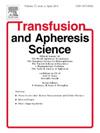Determinants of platelet transfusion practices in China: A nationwide survey on transfusionists’ preferences and barriers to whole blood-derived platelets adoption
IF 1.2
4区 医学
Q4 HEMATOLOGY
引用次数: 0
Abstract
Background
Despite the potential of whole blood-derived platelets (WBDP) to mitigate platelet shortages, their underutilization persists globally. This study investigates the perceptions of transfusionists and identifies barriers to the adoption of WBDP within China's blood supply system for tertiary hospitals.
Materials and methods
A structured questionnaire comprising 16 items was distributed through WeChat to 254 transfusionists working in tertiary hospitals across China. Data regarding demographics, platelet preferences, and operational challenges were analyzed using descriptive statistics for quantitative data and thematic analysis for qualitative responses.
Results
Results indicated a strong preference for AP (95.28 %), primarily attributed to perceived safety (80.99 %), efficacy (75.21 %), and familiarity with its use (76.86 %). In contrast, WBDP adoption was impeded by concerns over transfusion reactions (85.04 %), safety uncertainties (77.20 %), and operational challenges, such as increased workload (74.41 %) and higher labor costs (50.39 %). Despite this, 90.19 % of respondents expressed willingness to use WBDP during AP shortages, primarily due to critical shortages (66.81 %) and institutional mandates (33.19 %). Moreover, the key barriers included the risk of transfusion reactions (85.04 %), uncertainties regarding safety (77.20 %), doubts about efficacy (57.48 %), and increased labor costs (50.39 %).
Conclusion
Institutional inertia favoring AP, along with operational costs and workload for transfusionists, limit WBDP utilization. Implementing centralized compatibility testing and subsidy policies could improve contingency preparedness and address operational challenges.
中国血小板输注实践的决定因素:一项关于输液者偏好和采用全血源性血小板障碍的全国性调查
尽管全血源性血小板(WBDP)具有缓解血小板短缺的潜力,但其在全球范围内仍未得到充分利用。本研究调查了输血者的看法,并确定了在中国三级医院血液供应系统中采用WBDP的障碍。材料与方法采用16个项目的结构化问卷,对全国三级医院的254名输血师进行问卷调查。有关人口统计、血小板偏好和操作挑战的数据使用描述性统计进行定量数据分析,主题分析进行定性响应。结果结果显示,患者对AP有强烈的偏好(95.28 %),主要是由于感知到安全性(80.99 %)、有效性(75.21 %)和熟悉其使用(76.86 %)。相比之下,对输血反应(85.04 %)、安全不确定性(77.20 %)和操作挑战(如工作量增加(74.41 %)和较高的人工成本(50.39 %)的担忧阻碍了WBDP的采用。尽管如此,90.19 %的受访者表示愿意在AP短缺期间使用WBDP,主要是由于严重短缺(66.81 %)和机构要求(33.19 %)。此外,主要障碍包括输血反应风险(85.04 %)、安全性不确定(77.20 %)、疗效怀疑(57.48 %)和人工成本增加(50.39 %)。结论:支持AP的机构惯性,以及输血人员的操作成本和工作量,限制了WBDP的利用。实施集中兼容性测试和补贴政策可以改善应急准备并解决业务挑战。
本文章由计算机程序翻译,如有差异,请以英文原文为准。
求助全文
约1分钟内获得全文
求助全文
来源期刊
CiteScore
3.60
自引率
5.30%
发文量
181
审稿时长
42 days
期刊介绍:
Transfusion and Apheresis Science brings comprehensive and up-to-date information to physicians and health care professionals involved in the rapidly changing fields of transfusion medicine, hemostasis and apheresis. The journal presents original articles relating to scientific and clinical studies in the areas of immunohematology, transfusion practice, bleeding and thrombotic disorders and both therapeutic and donor apheresis including hematopoietic stem cells. Topics covered include the collection and processing of blood, compatibility testing and guidelines for the use of blood products, as well as screening for and transmission of blood-borne diseases. All areas of apheresis - therapeutic and collection - are also addressed. We would like to specifically encourage allied health professionals in this area to submit manuscripts that relate to improved patient and donor care, technical aspects and educational issues.
Transfusion and Apheresis Science features a "Theme" section which includes, in each issue, a group of papers designed to review a specific topic of current importance in transfusion and hemostasis for the discussion of topical issues specific to apheresis and focuses on the operators'' viewpoint. Another section is "What''s Happening" which provides informal reporting of activities in the field. In addition, brief case reports and Letters to the Editor, as well as reviews of meetings and events of general interest, and a listing of recent patents make the journal a complete source of information for practitioners of transfusion, hemostasis and apheresis science. Immediate dissemination of important information is ensured by the commitment of Transfusion and Apheresis Science to rapid publication of both symposia and submitted papers.

 求助内容:
求助内容: 应助结果提醒方式:
应助结果提醒方式:


